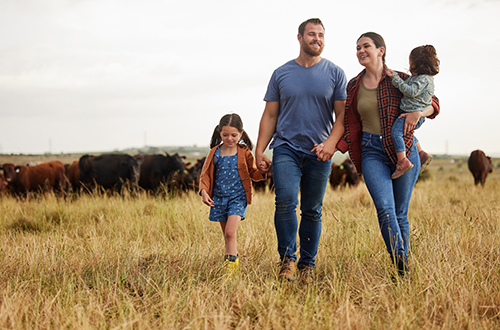Future-proofing the family farming business: Reviewing your business structure
At this year’s Annual Farming Families event, I spoke about the structure of farming businesses and why now might be the right time to review this.
Here is a summary of the key points covered during my talk.
Most farming businesses are set up as partnerships and there are many historic reasons as to why they have remained so.
Historically, incorporating a farming business was often advised against due either to the stamp duty costs associated with this or perhaps due to certain partners not owning their specific ‘share’ of all underlying assets of the partnership (such as the farmhouse), which would make for a very complicated share capital structure!
Additionally, as explained further below, with regards to the position which was later altered by the Hanson case, an incorporation (excluding the farmhouse, to be left outside perhaps because it was owned by only some of the partners, or to ensure it would still benefit from future CGT ‘own home’ relief) would have likely compromised the Agricultural Property Relief (APR) position on that asset for inheritance tax purposes (IHT).
Partnerships are often the ideal structure where you have multiple partners taking a profit share but perhaps some do not have an interest in the underlining land.
However, there are a number of risks associated with a partnership status including claims made against the trade and IHT that could mean a corporate structure would be (and having in recent years, become) more appealing.
Claims from third parties against the trading business
In an unfortunate event, such as an employee claiming for a wrongful dismissal or a customer or supplier taking legal action against the farm business, not only are the partnership assets exposed to the risk of third-party claims, but also (for unincorporated partnerships) potentially your personal assets as well. This is because one of the downsides of having a partnership is that you do not have limited liability protection like you do with a company.
Even if you did not have many assets outside of the partnership, this can be an issue where your partnership not only includes the farming assets but also other business assets such as investment properties, cottages etc.. They too could be exposed to claims made against the business.
Therefore, creating a separation perhaps by looking at your business structure and incorporating might be a way to mitigate this risk.
Inheritance Tax (IHT)
A lack of IHT planning could lead to a large amount of your farming business being lost to HMRC, equally too much ‘fear’ of IHT could lead to too much being passed down too early, such that there is a lack of ‘bloodline’ protection.
Having the business in a limited company means it easier to protect the ‘bloodline’, such that the control of the business would always be kept within the family.
The shareholders agreement could be written in such a way that in the case of divorce for example, the shares could be compelled to be offered back to the company, ensuring the continuation of the family business.
Agricultural Property Relief (APR)
As briefly referred to above, previously, common ownership of a business asset, such as a farmhouse was seen as a requirement in order to claim APR in full. This meant that having the ownership of the farmland in a separate limited company owned by a few of the partners was not particularly appealing.
The Hanson tax case brought about a decision which changed the views on farmhouses and APR, such that it was not common ownership that was needed but common occupation. Therefore, having the ownership (of the farmland and other purely farming assets) in a separate limited company owned by only a few partners may not cause the issue it once did.
Business Property Relief (BPR)
Over the last few years, many farming business have diversified such that the business activities have shifted and gradually moved towards activities other than farming. This typically includes letting out property, both commercial and/or residential. These activities are not seen as the “right” kind of business for BPR.
There is also the risk of a legislative change, especially given the new Labour Government (though at the time of my talk, this was a strong expectation of a change of Government, rather than a reality), and so the “wholly or mainly” test, which is basically a 51% trading activities test for BPR may change, which could lead to the farm business losing out on BPR altogether.
There are a few options to mitigate this risk, the first of which being to bank the reliefs sooner rather then later. This could include passing down ownership directly to younger partners, (such as children) however depending on the situation this may not be the best fit in terms of influence, control and responsibility.
Alternatively, a corporate structure could make this succession planning easier, with lots of possible share structures and planning opportunities depending on the objectives of the family. For example, shares could be easily put into a trust, banking the BPR (although the two year ownership requirement may be a barrier to doing this imminently after an incorporation) and different types of share structures could also be explored including the use of preference shares and growth shares.
Even if you did get to a situation where the investment side of the business is overtaking the farming business to the point where it is almost certain BPR would be lost, then the company could be split such that the farming business and the investment business are separated.
The investment business would not get BPR, however share structures could then be used to mitigate exposure to IHT.
Further considerations
There are potentially many advantages to incorporating the farming business, but there are further tax considerations such as Capital Gains Tax (CGT) and Stamp Duty Land Tax (SDLT) that will also need to be considered.
Approximately ten years ago, the Ramsey case showed that not only is a farming business a “business” for the purposes of capital gains incorporation relief, but so can be a rental business, where certain conditions are met. Therefore, even if the investments were substantial it can be possible to transfer the entire partnership business without triggering CGT, albeit this is subject to detailed review in advance of undertaking the transaction.
One of the conditions to claim incorporation relief is that all of the assets of the partnership need to be transferred into the company. This means that if you were to retain the farmhouse outside of the company, this could compromise the ability to claim the relief. However, it may be possible to argue that the farmhouse was not really a business asset, as such, depending on the exact circumstances.
It is worth considering if you have a proper partnership business as you can potentially incorporate without incurring any SDLT and it unlocks the ability to look at ring fencing the assets. This can be useful, particularly if you are not looking to sell off the assets soon and are not too worried about incurring a double layer of tax (Corporation tax and then Capital Gains Tax) on the disposal of assets further down the line.
Summary
In summary, a traditional partnership structure has often made sense in terms of allowing younger partners to have a profit share without a share of the underlying capital assets, and/or to avoid the IHT downside of separating the farmhouse ownership from the main farmland. It has also made sense from a BPR perspective to have trading and investment assets “mixed” in together (such that both the farming and investment assets can potentially qualify for 100% IHT relief).
However, developments such as the Hanson case, the increasing risk of litigation from third parties, the increased prospect of claims in divorce proceedings, and the evolution of more sophisticated company share structure and group structure planning, have moved the goalposts in terms of balancing those various risks, including the IHT risk. Furthermore, the Ramsey case has opened the prospect of tax-free incorporations, in certain scenarios, potentially immediately unlocking the associated tax benefits.
In this article we haven’t covered the further potential tax benefit of income tax savings, but this would be a further factor to consider as part of the overall assessment. In my presentation at the AFF event, I showed a group structure diagram which took the idea a step further showing that, post incorporation, the investment assets could even theoretically be ring-fenced from the farming business risks covered above, by being held within a holding company of the group.
If you require any further advice on incorporating a partnership or reviewing your business structure more broadly, please contact James Boustead at Rickard Luckin.
This article is from the latest edition of our Agricultural Briefing. To receive future copies of any of our newsletters directly to your inbox, please visit our preference centre to register your interest.
If you have any questions about the above, or would like more information specific to your circumstances, please enter your email address below and we will get in touch:
















